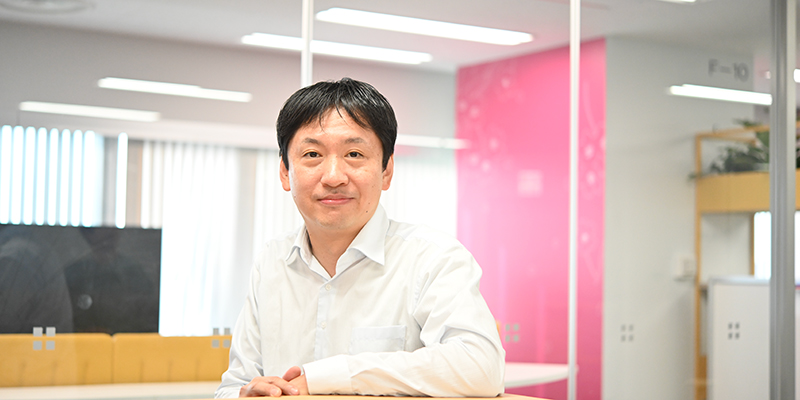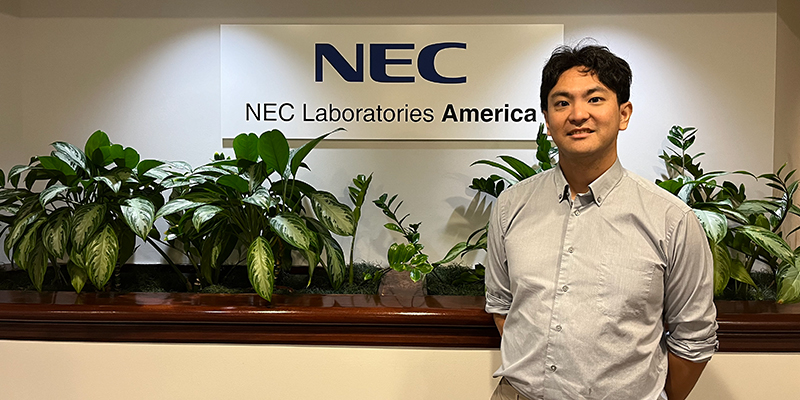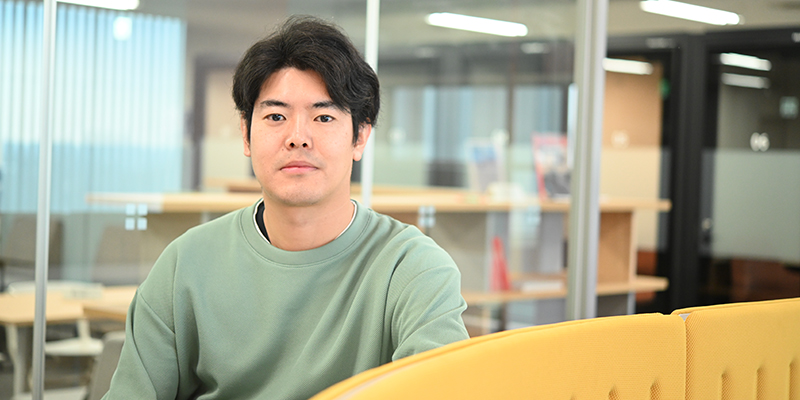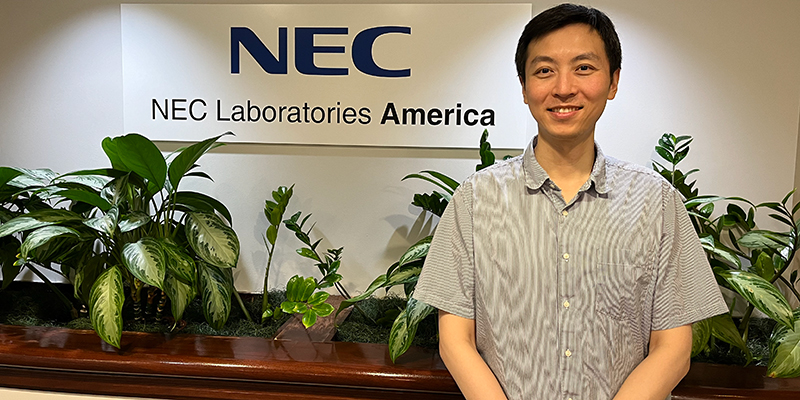Global Site
Breadcrumb navigation
Utilizing NEC's Fiber Optic Sensing Technology Worldwide
Featured TechnologiesThe U.S. and Japan work as one team to visualize the real worldDecember 6, 2024

NEC has long been a world leader in optical communication and AI technologies. The company is using both expertise to conduct research into NEC's unique Fiber Optic Sensing technology. With the US and Japanese teams working closely together, they are taking on the significant challenge of leveraging network infrastructure to make the real world visible through Fiber Optic Sensing.
Optical fiber sensing technology makes it possible to detect and predict physical events and activities across the globe.

Director
Tomoyuki Hino
―Could you please explain what is Fiber Optic Sensing?
Hino: Fiber optic sensing is a technology that uses fiber optics to measure vibration, temperature and sound. By combining this sensing technology with AI analysis, existing fiber optic infrastructure, such as that of telecommunications companies, can be used as sensors. This is NEC's proprietary technology. The advantages of using existing optical fibre are that the cost of laying new optical fiber can be reduced and, as optical fiber is available worldwide, sensing over a wide area is possible.
Kohno: By combining sensing and AI analysis technologies, the system can first detect sound, temperature and vibration, and then predict real-world events, using AI analysis to detect data.

Researcher
Wataru Kohno
―Thank you for explaining. For example, how can this technology be used?
Yue :For example, it is possible to track vehicles on the road and detect the type of vehicle, driving direction, speed, and congestion of vehicles.
It also may be possible to detect extreme weather conditions such as hurricanes, earthquakes, gunshots, and people calling for help.
Kohno: Let me give you specific examples. In one case, this technology could be used to report to telecom operators in real time where and how fiber is cut or damaged, whether underground fiber is cut during construction work, or if it is damaged by a hurricane, earthquake, or other events. Once this is done, operators can quickly dispatch repair teams to the damaged fiber so that their services can be restored immediately.
In other cases, Fiber Optic Sensing technology can also be useful for detecting suspicious objects and intruders. We provided a suspicious object detection solution for an airline. Airlines may find it difficult to install cameras in public areas due to privacy issues. In such cases, Fiber Optic Sensing technology can be used to detect suspicious persons or intruders, such as drones, without the need for cameras.
Japan and the US are working as ‘one team’ to develop technology and implement it in business through strong cooperation.

Assistant Manager
Daisuke Ikefuji
―What are the respective roles of the Japanese and US teams?
Hino: I think it is very clear. The US team's mission is to create a core technology, because they develop new technologies that form the core of the NEC. The mission of the Japanese team is to conduct applied research to put the core technology created by the US team into practical use. Towards practical use, they get AI algorithms using high-quality data obtained through demonstrations in customer environments. Another important role of the Japanese team is to connect with infrastructure companies. NEC has strong connections with infrastructure companies as it provides a number of infrastructure projects, including road, rail, and telecommunications projects. The data is then acquired from its multiple infrastructure companies to help improve the AI algorithms.
Yue: Japan is NEC’s home ground, after decades of high-quality products and service delivery. NEC has already built a strong reputation and earned the trust of customers in Japan. Therefore, it’s easier for customers in Japan to have an open mind about trying our technology or collaborating with us to develop new applications or use cases. This is what the US team can not easily do in the US or in Japan.
The team in Japan provided us with strong support to trial our technology with customers and speed up the commercialization of not only fiber sensing, but other promising technologies.
Ikefuji: I am on the Japan team, and we are working with a Japanese customer on applied research. Let me briefly introduce one case that we are actually working on. I am currently involved in a project to enable safe autonomous driving on highway sections. We are working on this project together with Japanese road management company, and we use fiber optic sensing technology to determine the condition of the motorway. For example, it detects information on traffic congestion, wet or icy road surfaces and other anomalies on the road. By doing so, the system aims for smoother and safer automated driving by linking and providing road information that cannot be detected by the sensors in the vehicle alone. Good results were obtained in Results of previous demonstration tests , and the aim is to put the system into practical use in the future.
Hino: Each member is engaged in work that allows them to utilize their individual interests and strengths. Ikefuji-san is interested in implementing technology in the real world and making it useful. For that reason, he is engaged in applied research in the road field. Meanwhile, Kohno-san is interested in creating new technologies, so he has been seconded to the US team to work on core technology research.
Kohno: As Hino-san said, I am interested in creating new technologies. Coming to the US team, I am looking into a lot of research from a technical and fundamental point of view, trying to create something new.
―What do you consider to be the key elements in the US team and Japanese teams working together as one?
Yue: I think one big component or perhaps most important thing is we share the same values as the team in Japan and as a result, we have the same goal. Making sure that we can work towards the same ultimate goal is very important. Good and highly efficient communication is another key factor. You can see that Kohno-san is currently part of our US team, but he was previously in Hino-san’s team. The Japan team consistently sends talented researchers to the US team, allowing us to work more closely together, which strengthens our bond as one unified team.
In this way, we can push forward towards our shared goal more efficiently.
Hino: Of course, there are some issues about time difference and locations. However, I think the important thing is, as Yui Tien-san said, that we share the same goal and good communication. With these two things, time difference and distance are not a big issue.
Ikefuji: The same is true when working with the Japanese business sector. It is important that the business and research departments have a firm sense of purpose pointed in the same direction, even if there are no time difference or distance problems as there are in the US. Sometimes when the business team asks us to create some technology, they do not explain why they need it. However, unless the business department has clearly identified the customer's objectives, we end up creating technology that is different from what they have requested. If that happens, there is no point. Therefore, it is important to work together with a clear understanding of the objectives, holding discussions with customers as needed.
Making the world visible to build a better and brighter society.

Senior Researcher
Yue Tian
―Will you be focusing exclusively in Japan for the future implementation, or are you considering a global approach?
Yue: The answer is definitely both. We want to focus on both domestic and in the US. Japan is NEC's home ground, making it the ideal place to trial our technology with customers and refine it into a useful solution. Once polished, we can bring it back to the US for other customers. As for the US team, I believe we can leverage our location on the East Coast to our advantage. We have better access to the US, European, and South American markets, as well as industries , that the US is still leading in technology innovation, such as telecom, public safety and security, so an early success with the customer in these industries in the US will naturally give us more opportunity across the whole globe. Not only Japan and the US but the whole world.
I think the access to the cutting-edge technology innovations is another reason why we cannot give up the US market or any market outside of Japan. Yeah, that's why we want to focus on both. We cannot lose any of them, Japan or other markets.
―This is last question. Could you please share the future goal and how it will contribute to society?
Hino: In the future we aim to collect environmental information such as vibration sound in real time from optical fiber infrastructures already installed all over the world. Our goal is to properly understand the wide area's situation, and create and contribute to NEC’s business.
Yue: Using our optical fiber sensing technology, we would like to understand our environment, the whole society in a better way. In doing so, we will embody NEC's slogan: orchestrating a brighter world.
- ※The information posted on this page is the information at the time of publication.
